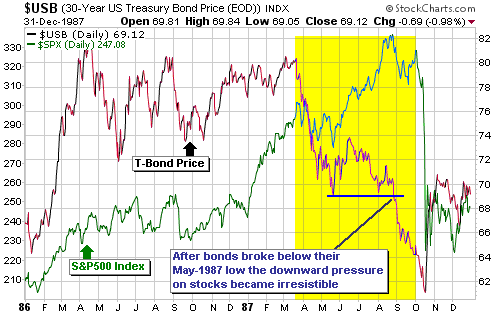|
|||
The Bearish Bond DivergenceSteve Saville
As noted many times in previous TSI commentaries, a downward trend in the bond market will eventually take its toll on the stock market. It's a question of when, not if, a downward trend in the bond market will drag equities lower. The 'when' is typically 5-7 months, but is sometimes as long as 12 months from the start of the bond market's decline. The current situation is that bonds are about 6 months into a downward trend, so we have entered the time-window when weakness in bonds should be starting to have an adverse effect on the stock market. Clearly, weakness in bonds did have an adverse effect on stocks over the past several trading days. If the bond market's decline continues without significant interruption over the next few weeks then a knock-on effect will almost certainly be a sharp stock market correction. However, a short-term bottom might have just been put in place in the bond market; in which case the probability of the stock market experiencing a sharp near-term correction has been reduced. If bonds have just set a short-term low or do so in the very near future, then the inter-relationship between bonds and stocks over the next several months could turn out to be similar to their inter-relationship during the second half of 1987. To put it mildly, 1987 provides us with a good example of how weakness in the bond market will eventually influence the stock market in a negative way. There isn't a realistic chance of 2007 giving us something akin to a 1987-style stock market crash, but there is a very good chance that additional weakness in the bond market later this year would precipitate an equity bear market. With the aid of the following chart we'll now quickly review what happened during 1987. Note that the shaded area on the chart indicates the period of divergence between bonds and stocks (bonds trending lower in parallel with stocks trending higher). The chart shows that US T-Bonds commenced an intermediate-term decline in March of 1987. The initial phase of this decline prompted some consolidation in the S&P500 Index, but equity traders largely ignored it. However, equity traders sat up and took notice after the T-Bond price broke below its May-2007 bottom in September of that year. This was the point when the stock market embarked on a decline that would culminate in one of the most famous financial market events in history (the 1987 stock market crash). Thanks to the October-1987 stock market crash, a bearish divergence between the stock and bond markets that had been building for many months was eliminated within the space of a few days.  The current bearish divergence between stocks and bonds will have to be eliminated, too, one way or the other. Here, in our opinion, are the three most likely ways: 1. The bond market soon commences an intermediate-term rally to bring itself into line with the stock market 2. The stock market corrects sharply over the coming 1-2 months, thus bringing itself into line with the bond market 3. In a variation of the 1987 story, bonds make a short-term bottom this month and the overall divergence continues to build for a few more months. Then, a breakdown in the bond market (a break below this month's low) later this year pushes stocks into a cyclical bear market. In our opinion the first of the above-described scenarios has by far the lowest probability because we can't imagine bonds embarking on a lengthy advance in the absence of substantial weakness in the stock market; in other words, we think an intermediate-term stock market decline will have to precede the next intermediate-term bond rally. On the other hand, we think the third scenario has the highest probability. The third scenario is consistent with the likelihood of a June reversal in the bond market and with the late-1960s analogy we've discussed over the past month (there was a cyclical bear market in equities during 1969-1970). If the third scenario plays out then the stock market will resume its advance after bonds reach a short-term bottom and it will continue to trend higher until bonds break to new lows later this year. In any case, regardless of the paths taken by the markets over the coming months the most important thing to keep in mind is that an equity rally's days are numbered once bonds commence an intermediate-term decline. We can come up with potential scenarios until the cows come home, but all we really need to know is that stock market risk will increase exponentially if the bond market's decline extends much further -- either immediately, or following a counter-trend rebound. Steve Saville Regular financial market forecasts and analyses are provided at our web site: We aren't offering a free trial subscription at this time, but free samples of our work (excerpts from our regular commentaries) can be viewed at: http://tsi-blog.com Saville Archives |
